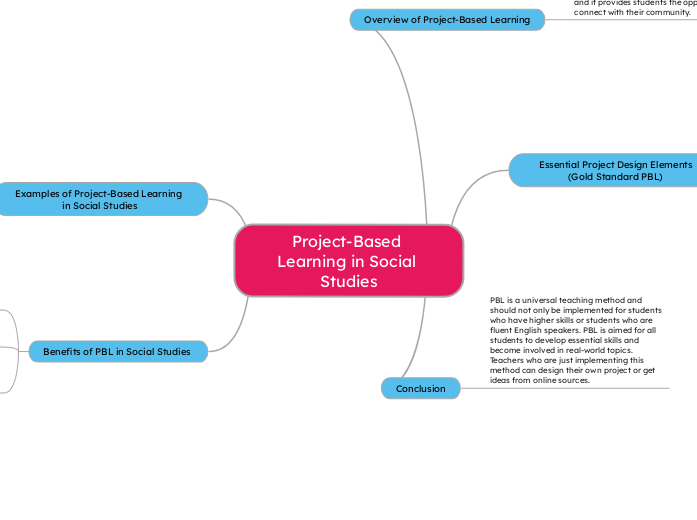Project-Based Learning in Social Studies
Overview of Project-Based Learning
Project-Based Learning is a new perspective on learning in the classroom. PBL is a teaching method that engages students in their learning, leading to better knowledge retention. Through PBL, students learn more factual knowledge as well as discreet skills and it provides students the opportunity to connect with their community.
Essential Project Design Elements (Gold Standard PBL)
Challenging Problem/Question
The project introduced to the class is based on a problem/ overall question that needs to be answered.
Sustained Inquiry
Students take the challenging question/problem and engage in discussions, resources and apply their known information.
Authenticity
The project focuses on a real-world context and is usually aimed towards students personal concerns/interests.
Student Voice and Choice
Students have the creative freedom to make decisions about the project and what they will create.
Reflection
With the help of the teacher, students will reflect on their learning as well as the quality of their work.
Critique & Revision
Students give and recieve feedback on their draft to improve their products.
Public Product
Students present their project explaining their process to people beyond the classroom.
Conclusion
PBL is a universal teaching method and should not only be implemented for students who have higher skills or students who are fluent English speakers. PBL is aimed for all students to develop essential skills and become involved in real-world topics. Teachers who are just implementing this method can design their own project or get ideas from online sources.
Examples of Project-Based Learning in Social Studies
A museum exhibit about a historial time, place, person or event.
An action or service learning project to benefit the community.
A proposal for a monument that explains a historical event.
An online map about local history.
Benefits of PBL in Social Studies
Deeper Engagement
As students do more and have the creative freedom to explore more, they will want to learn more about topics that interest them.
Fosters Creativity
Through scaffolding and resources, students are able to create a project that excites them and is meaningful to them.
Communication Development
Introducing an exciting project to the class will generate lots of questions as well as encourage students to practice their communication through class discussions or in writing form.
